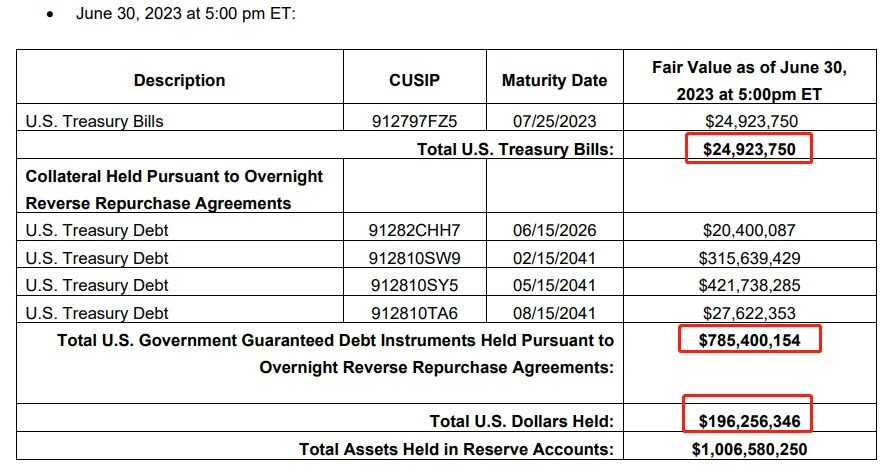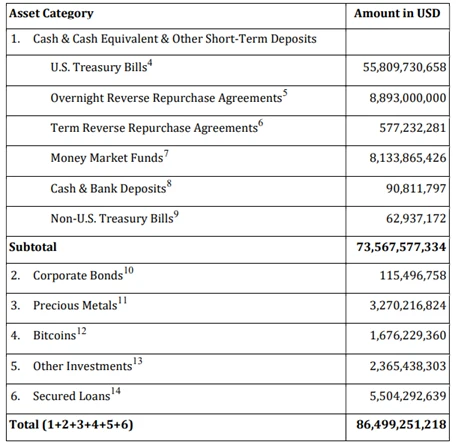Original source: Ouke Cloud Chain Research Institute
Original author: Matthew Lee
On August 7, 2023, PayPal, which has 431 million users, announced the issuance of the stable currency PYUSD with Paxos. As a company regulated by the New York State Department of Financial Services, Paxos specializes in providing stablecoins that are equivalent to legal currencies such as the US dollar. However, Paxos has gradually faded out of the public eye after being named by the SEC.
Why is Paypal joining hands with Paxos to return to the public eye?
First of all, as a US compliance company and a fully licensed limited purpose trust company, Paxos releases stablecoins that have natural advantages in compliance and US dollar asset selection.
Secondly, on the asset disclosure side, Paxos also does its best to regularly disclose the share of U.S. debt holdings and stablecoin circulation, and publish audit reports. Taking USDP as an example, according to the audit report disclosed in the figure below, they are anchored with abundant cash, short-term treasury bonds, and highly liquid assets repurchased by the Federal Reserve.

Image source: Paxos official website
Although the U.S. dollar stablecoin BUSD jointly launched by Paxos and Binance was forced to stop minting by New York State regulators in February because the anchor assets of BUSD on the non-Ethereum chain were not sufficiently prepared, it did not involve other issued currencies. Its stablecoins USDP and PAXG have not been subject to regulatory crackdowns and have sufficient liquidity in the market.
There are already enough stablecoins on the market, so why continue to fry them?The main reason is still: Profitable.

Image source: Tether official website
According to the audit report disclosed by Tether in the first quarter, its total asset management was as high as $86.5 billion, and the net profit disclosed in the first quarter alone was $1.48 billion, while there were only a few dozen employees. The issuance of stablecoins alone can make them a lot of money.
PayPals recent performance in both financial reports and business development has been mediocre. Investors were disappointed with quarterly operating margins, but the stock rose 3% the day the stablecoin launch was announced.If Tether earns a profit of $1.48 billion with a market share of 60%, when PYUSD gains a market share of 15%, under the same market environment (regardless of operating costs, non-operating expenses and taxes, etc.), Paypal A profit of $370 million is possible, equivalent to a profit increase of 46.5%.
Stablecoin issuance has a wide impact, and regulatory regulations are indispensable
Many problems will arise during the issuance process of stablecoins. For example, after PayPal issued stablecoins, counterfeit coins sprung up like mushrooms after a rain. Counterfeiting stablecoins has become a common tactic for scammers. According to OKLink Explorer, Tether, which has the highest market share of stablecoins, has also been counterfeited by illegal personnel, causing losses to many investors.

Image source: OKLink Explorer
Patrick McHenry, chairman of the U.S. House of Representatives Financial Services Committee, told PayPals launch of payment stablecoins, Issued under a clear regulatory framework, stablecoins are expected to become the backbone of the payment system in the 21st century. Clear regulations are critical for stablecoins to realize their potential.
The attitude of US regulators towards stablecoins can be seen from the public attitude of high-level officials. However, due to the nature of the “currency” of stablecoins, it has replaced some of the responsibilities of the central bank’s legal tender to a certain extent, so it is more likely to cause market system turmoil. For example, the central bank conducts open market operations by minting currency to purchase securities, lending to banks, etc., thereby affecting the money supply and manipulating interest rates. butThe emergence of stable coins can destroy the monopoly of the central bank,It makes the currency appreciate/depreciate, leading to inflation/deflation, so the issuance of stable coins needs to be carried out under a sound regulatory framework.
Another very important one,But an area that has been ignored by many people is stablecoin anti-money laundering.
Kenneth Blanco, director of the Financial Crimes Enforcement Network (FinCEN), pointed out that stablecoins also need to comply with anti-money laundering laws.Issuers of stablecoins are classified as money service businesses (MSB) and are also required to comply with the same but more stringent regulations as exchanges.Because the compliance requirements of the exchange are relatively simple, they only need to control the funds at the deposit and withdrawal ports. The circulation and issuance of stablecoins are more complex and require more complex on-chain tracking activities, so stricter KYC and AML measures are required.
Tether, the so-called “decentralized” stablecoin issuer, also needs to follow regulatory instructions and cooperate with on-chain data service providers. To fulfill anti-money laundering compliance responsibilities, an on-chain blacklist mechanism has been developed. Any address suspected of engaging in illegal activities such as fraud, money laundering, and terrorist financing,Will be included in Tethers blacklist. Currently, Tether has frozen hundreds of millions of USDT.
According to information on PayPals Github, Paxos must have an asset protection role due to regulatory requirements. This means that when the law requires freezing or seizing the assets of the criminal party, the address with the AssetProtectionRole permission can initiate freezing, unfreezing or even erasing the balance of any account. This allows the relevant authorities to effectively seize the corresponding assets. otherwiseStablecoins allow huge amounts of money to change hands without touching the formal banking system,Can enable criminals to engage in large-scale money laundering operations.
In order to meet the regulatory needs to the greatest extent,PayPal has also cooperated with on-chain data service providers.Monitor criminal activities on the chain and monitor blockchain nodes in the early stages.
The role of on-chain data service providers in supervision cannot be ignored
As a bridge between real assets and virtual assets, stablecoins are highly valued by governments of various countries (regions). Hong Kong, one of Nylon Harbor, plans to launch a Hong Kong dollar stablecoin in 2024 to improve the efficiency and inclusiveness of Hong Kongs financial system, and is developing a detailed stablecoin regulatory framework to regulate the orderly development of stablecoins. Realizing the urgent need for supervision and the rampant crime on the chain, OKLink’s product chain AMLThe KYT function can also use the huge address tag library to obtain the relevant source of funds in real time, and comprehensively monitor the addresses controlled by the entity according to the customized anti-money laundering strategy for real-time early warning. After identifying high-risk activities, on-chain data tracking and digital asset tracing can be quickly carried out, thereby fully curbing illegal activities such as money laundering.
Regulation has higher compliance requirements for stablecoin issuers, so powerful on-chain data service providers need to play the role of on-chain police.OKLink has 3.4 billion+ address label data and spans 170+ public chains, which can better serve the needs of project parties and commercial organizations in terms of compliance.










